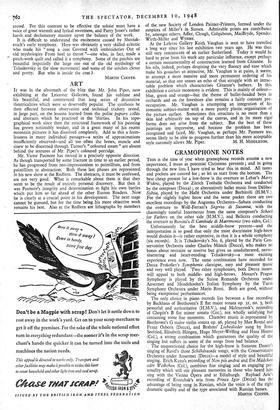ART
IT was in the aftermath of the blitz that Mr. John Piper, now exhibiting at the Leicester Galleries, found his sublime and his beautiful, and commenced that long series of decorative theatricalities which were so deservedly popular. The synthesis he then effected between observation and technical trickery rested, in large part, on the lessons learned from the polite pa piers colles and abstracts which he practised in the 'thirties. In his topo- graphical work since then the structural framework of his painting has grown noticeably weaker, and in a great many of his recent mountain pictures it has dissolved completely. Add to this a form- lessness in many individual passages—a series of approximations insufficiently observed—and all too often the bones, muscle and sinew to be discerned through Turner's "coloured steam" are absent behind the textures of Mr. Piper's coloured porridge.
Mr. Victor Pasmore has moved in a precisely opposite direction. As though transported by some fracture in time to an earlier period, he has progressed from neo-impressionism to pointillism, and from pointillism to abstraction. Both these last phases are represented in his new show at the. Redfern. The abstracts, it must be confessed, are not very good. What is remarkable about them is that they seem to be the result of entirely personal discovery. But then it was Pasmore's integrity and determination to fight his own battles which put him so far ahead of the other Euston Roaders. Now he is clearly at a crucial point in his development. The next stage cannot be guessed, but for the time being his more objective work remains his best. Also at the Redfern are lithographs by members of the new Society of London Painter-Printers, formed under the auspices of Miller's in Sussex. Admirable prints are contributed by, amongst others, Adler, Clough, Colquhoun, MacBryde, Spender. Wirth-Miller and Wynter.
At the Lefevre Gallery Keith Vaughan is seen to have travelled a long way since his last exhibition two years ago. He was then still very reminiscent of an earlier Sutherland. Today it would be hard to prise from his work any particular influence, except perhaps a certain monumentality of construction learned from Cezanne. In his oils, indeed, perhaps despising the very fluency and ease which make his gouaches so attractive, Mr. Vaughan is at pains, it seems, to attempt a more massive and more permanent ordering of his material, so that one senses an echo of that struggle with an intrac- table problem which characterises Cezanne's bathers. In this exhibition a certain monotony is evident. This is mainly of colour— blue, green and orange—but the theme of bullet-headed boys in orchards and on the foreshore also remains a fairly constant pre- occupation. Mr. Vaughan is attempting an integration of his romantic subject-matter with a more purely plastic organisation of the picture surface. Sometimes this structure is no more than a skin laid arbitrarily on top of the canvas, and in its more rigid forms does not arise from the subject. But the best of these paintings are impressive, and because the problem has been recognised and faced, Mr. Vaughan, as perhaps Mr. Pasmore too, seems likely to be able to progress further than his more acceptable














































 Previous page
Previous page